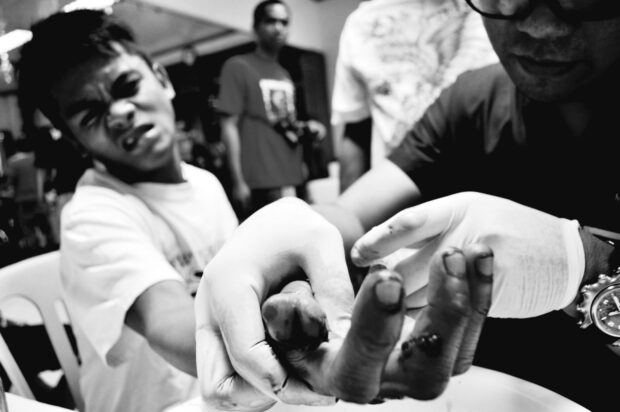Don’t lose a limb this new year

At least 96 firework-related injuries have already been reported—and the clock has not even struck midnight yet to signal the transition from the old to the new year later tonight.
It’s a New Year’s Eve (NYE) tradition in the Philippines to light up fireworks and firecrackers carried over from the superstition that doing so would help ward off evil spirits and drive away bad luck. But bad luck has already fallen on these 96 who were injured, most of them males and many of them minors. The Department of Health (DOH) said nearly all fireworks-related injuries happen at home and on the streets. Six of the injuries recorded required amputations and were from illegal firecrackers that have long been regulated under Republic Act No. 7183 enacted in 1992. “Fireworks are not toys. They may be nice to see, but are deadly,” said the DOH.
The Department of the Interior and Local Government (DILG) has called on local government units (LGUs) to strictly enforce ordinances prohibiting harmful fireworks. In 2017, then President Rodrigo Duterte issued Executive Order No. 28, banning fireworks in households or places of residence nationwide, and allowing only community fireworks displays; private companies staging fireworks shows need a permit and the supervision of experts.
Community fireworks display
This week, DILG Secretary Benhur Abalos urged LGUs to supervise fireworks displays in common areas such as city or municipal hall grounds, and other designated places to avoid accidents. At least 1,210 LGUs have ordinances banning the use of harmful firecrackers. “Make sure that these ordinances are enforced. Let’s put teeth into these ordinances against dangerous fireworks. These policies are meaningless if we do not implement them in our barangays,” Abalos said.
But what exactly is allowed and what is banned? Per DILG, fireworks or “pailaw” are allowed in homes or private compounds. These include sparklers, luces, fountain, jumbo regular and special, mabuhay, roman candle, trompillo, airwolf, whistle device, and butterfly. Firecrackers or “paputok,” on the other hand, should be limited to community fireworks displays and under the supervision of a trained person duly licensed by the Philippine National Police. Based on the PNP’s list of banned fireworks, these include the common five star, giant bawang, watusi, atomic triangle, Judas’ belt, as well as those with quirky names like Super Yolanda, Super Lolo, Coke-in-Can, pla-pla, piccolo, Goodbye Philippines, and Goodbye Bading.
Filipinos’ penchant for firecrackers
To guarantee safety and quality, the Department of Trade and Industry has released a list of 14 certified brands of fireworks with Philippine Standard license numbers. The PNP also warned against buying firecrackers and pyrotechnic devices from online platforms as this is prohibited and could even be a violation of the Cybercrime Prevention Act.
Despite these laws and local regulations, and on top of DOH’s perennial warning that fireworks and firecrackers can cause injuries like blasts or burns that may require amputation, eye injury, tetanus, poisoning, or even death, the individual or private use of these harmful firecrackers persist. Filipinos’ penchant for firecrackers—the more dangerous, the better apparently—has given rise to a thriving pyrotechnics industry in Bulacan, where many manufacturing factories are located. This year though, sellers have noted low demand due to high inflation. Consumers are instead prioritizing food for “media noche” and other cheaper options such as sparklers or “torotot” (horns).
‘Hanabi’ culture in Japan
This bodes well for the government’s campaign but not so for manufacturers who believe that regulating and monitoring illegal firecrackers and pyrotechnics should be prioritized instead of a ban. Perhaps the government should take a look at the “hanabi” culture in Japan, where craftsmen who have learned the skills from their elders have transformed fireworks displays into an art. Hanabi, literally “fire flower,” has become part of the Japanese culture that people can enjoy through awesome and colorful displays during local festivals. LGUs can lead the way in turning NYE celebrations into something similar: Caloocan and Taguig have previously done it in designated sites, and Quezon City, which has imposed a total ban, is instead inviting the public to a countdown and fireworks display at Quezon Memorial Circle.
Times have changed—many can enjoy NYE festivities at home while watching TV broadcasts or online streams, or through community fireworks displays. No need to go out on a limb, or literally lose one, to welcome 2024.
Happy New Year!




















